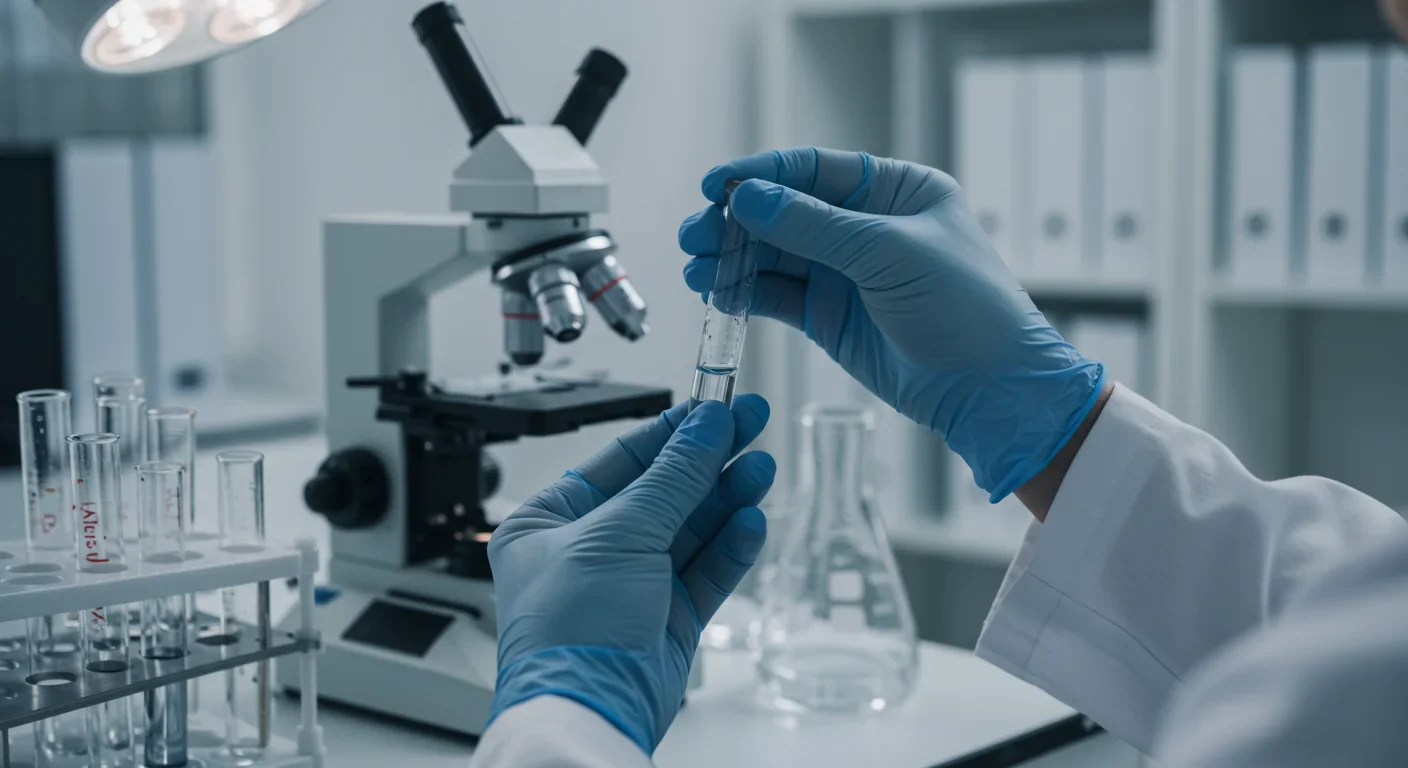How Compassion Meditation Rewires Your Brain & Cuts Inflammation

TL;DR: Phthalates in everyday plastics reduce testosterone by up to 34% in boys and impair male fertility. These chemicals enter through food packaging and personal care products, affecting vulnerable populations disproportionately.

In your water bottle. Your shower curtain. The lining of your food cans. A class of chemicals called phthalates has infiltrated virtually every corner of modern life, and mounting evidence suggests they're quietly dismantling male reproductive health one molecule at a time. Within the next decade, if current trends continue, we may witness fertility rates plummet to levels that fundamentally alter how societies function.
The numbers tell a stark story. Recent occupational studies show that men exposed to di-n-butyl phthalate (DnBP) experience measurable testosterone reductions, with free testosterone levels dropping in direct proportion to phthalate metabolites in their urine. Even more alarming, research published through the National Health and Nutrition Examination Survey found that boys ages 6–12 with elevated DEHP metabolites showed a 24 to 34.1% drop in testosterone, a hormonal hit comparable to middle-aged adults. This isn't a distant threat. It's happening now, to children, during the critical window when their reproductive systems are developing.
Phthalates work as endocrine disruptors, chemicals that interfere with hormone production and signaling. These plasticizers don't just pass through harmlessly. Once absorbed, they target Leydig cells in the testes, the specialized cells responsible for testosterone synthesis. The chemical assault happens through multiple pathways: phthalate metabolites act as androgen receptor antagonists, blocking the body's ability to respond to testosterone, while simultaneously disrupting the enzymatic pathways that produce the hormone.
Laboratory studies reveal the precise mechanism. When human Leydig cells are exposed to just 2 µM of DEHP, testosterone synthesis drops significantly. That's not a massive dose; it's a concentration people encounter regularly. Animal models show the full cascade: chronic exposure at 50–500 mg/kg/day for 30–90 days produces testicular atrophy, plummeting sperm counts, and damaged sperm DNA.
But humans aren't rats, so why worry? Because epidemiological data from real-world populations mirrors the animal findings. Workers in PVC manufacturing show reduced semen quality: lower sperm counts, impaired motility, and increased DNA fragmentation. Their urinary metabolite levels correlate directly with reproductive dysfunction severity.
Most people assume chemical exposure requires working in a factory. Phthalates shatter that assumption. The primary route isn't occupational; it's your dinner plate. Food ingestion accounts for the majority of phthalate exposure in the general population, because these chemicals leach from packaging materials into food itself.
Personal care products represent another major vector. Shampoos, lotions, perfumes, and cosmetics frequently contain phthalates as solvents and fragrance carriers, leading to dermal absorption and inhalation whenever you use these products. Pregnant women who documented their daily use of personal care items in detailed diaries showed corresponding spikes in urinary phthalate metabolites.
Even eco-friendly choices might backfire. A study of reusable plastic water bottles found that 22 out of 39 bottle types released DIBP, a phthalate classified as toxic to reproduction, especially after dishwashing. Concentrations ranged from 3.13 to 57.16 ng/mL after ten days of simulated use. The bottles marketed as eco-friendly turned out to be chemical reservoirs.
Inhalation represents a pathway most people never consider. Phthalates appear in vehicle exhaust, meaning urban air quality issues extend beyond carbon monoxide. Indoor air isn't safer; off-gassing from vinyl flooring, plastic furniture, and building materials creates constant low-level exposure, particularly concerning for children who spend more time on the floor.

Biomonitoring data from the EPA shows that urinary MEHP concentrations in the general population range from 10 to 300 ng/mL, with many individuals exceeding 50 ng/mL, the threshold where reproductive effects have been documented. The European Food Safety Authority has set an acceptable daily intake of 0.05 mg/kg/day for DEHP, but real-world monitoring indicates that workers in PVC-heavy industries frequently exceed this limit, sometimes by an order of magnitude.
The occupational health research provides the clearest dose-response data. A 2025 study presented at the Society for Endocrinology conference found negative associations between calculated free testosterone and DnBP metabolites, with beta coefficients showing that for every unit increase in urinary MnBP, free testosterone dropped by 0.002 units (P = 0.022). Newer-generation phthalates, introduced as supposedly safer alternatives, showed similar inverse relationships with male sexual health scores.
Population studies reveal that environmental levels, only slightly above baseline, produce measurable effects. The University of Michigan research on 2,208 NHANES participants found testosterone reductions in women ages 40–60 (10.8–24% decline) and dramatic drops in young boys. This isn't about extreme industrial accidents. It's about everyday exposure to products on store shelves.
Age matters profoundly when assessing phthalate risk. Fetuses and young children face the greatest vulnerability because their endocrine systems are actively developing. Prenatal exposure can produce what researchers call "phthalate syndrome" in male offspring: shortened anogenital distance, undescended testes, and hypospadias. These aren't cosmetic issues; they're structural changes that predict future fertility problems.
The NHANES data revealed something unexpected: women and children show the most dramatic testosterone reductions relative to baseline, not adult men. While testosterone is typically framed as a male hormone, women require it for bone density, muscle mass, libido, and overall metabolic health.
Socioeconomic and racial disparities compound the biological risks. EPA biomonitoring found that Black non-Hispanic women had higher median concentrations of all phthalate metabolites compared to White non-Hispanic women. Similarly, women and children living below the poverty line showed elevated phthalate levels. These patterns likely reflect differences in product access, with lower-cost personal care items and processed foods containing higher phthalate concentrations.
Occupational groups represent another high-risk category. Workers manufacturing PVC products, hospital staff handling medical tubing and IV bags, and anyone in industries using plasticizers as solvents face exposures far exceeding the general population. The Male Sexual Health Questionnaire total score has emerged as a sensitive clinical marker for phthalate exposure.
Regulatory responses have been fragmented and reactive rather than comprehensive. In 2017, the U.S. Consumer Product Safety Commission permanently banned eight phthalates in toys and child care articles. The European Union has taken broader action through REACH regulations, restricting DEHP, DBP, BBP, and DIBP in various applications.
Yet massive loopholes remain. Some jurisdictions ban phthalates in children's products but allow them in adult items, as if adults don't experience endocrine disruption. DIBP, despite being prohibited in food contact materials under EU Regulation 2023/1442, still appears in reusable bottles because it enters as a catalyst residue during manufacturing. This technicality allows harmful chemicals to bypass bans.
The FDA has been slower to act on food packaging, despite clear evidence of migration from containers into food. Medical devices present an even thornier problem: DEHP makes PVC tubing flexible, a critical property for IV lines and catheters. Hospitals have begun switching to alternatives like DOTP and citrate esters, but these replacements lack extensive long-term safety data.
The regulatory approach suffers from a fundamental flaw: it's chemical-by-chemical rather than class-based. Manufacturers respond to DEHP restrictions by substituting similar phthalates with slightly different molecular structures. Studies show these "next-generation" phthalates like DiPeP, DnoP, and DnHepP exhibit similar inverse associations with sexual health scores.

The good news: phthalates metabolize and excrete relatively quickly, so reducing exposure can lower body burden within days to weeks. Biomonitoring studies confirm that when people switch products, urinary metabolite levels drop measurably.
In the kitchen: Choose fresh, whole foods over processed and packaged options. Store food in glass or stainless steel containers, not plastic. Never microwave food in plastic containers; heat accelerates chemical migration. Avoid canned foods with plastic linings.
Personal care products: Read ingredient lists. "Fragrance" or "parfum" often conceals phthalates. Choose phthalate-free cosmetics, which major retailers now stock. Skip nail polish or choose "3-free" or "5-free" formulations.
Around the house: Replace vinyl shower curtains with fabric ones. Choose wood, tile, or linoleum flooring instead of vinyl. When buying furniture, ask about flame retardants and plasticizers. Dust and vacuum frequently, because phthalates accumulate in household dust.
Water and beverages: Switch to glass or stainless steel water bottles to avoid DIBP found in reusable plastic bottles. Don't reuse single-use plastic bottles; degradation from wear and heat increases chemical leaching.
For parents: Scrutinize toys, teethers, and baby products. Post-2017, children's products should be phthalate-free by law in the U.S., but imported or older items may not comply. Avoid plastic toys labeled with recycling codes 3 (PVC) or 7.
Medical considerations: Patients requiring extensive medical interventions face unavoidable phthalate exposure from PVC tubing. Ask healthcare providers about phthalate-free alternatives when available.
Despite two decades of research, critical questions remain. Longitudinal studies tracking the same individuals over years could establish causation more definitively than the cross-sectional designs that dominate current literature. We know phthalate exposure correlates with lower testosterone and impaired fertility, but does reducing exposure reverse the damage? The timescale of recovery remains unclear.
Transgenerational effects present an especially disturbing frontier. Animal studies demonstrate that DEHP exposure can affect reproductive health across multiple generations, suggesting epigenetic changes that persist even after exposure ends. If the same holds true in humans, then today's exposures may compromise the fertility of grandchildren not yet born.
The cocktail effect, where multiple endocrine disruptors interact synergistically, has barely been studied. Real-world exposure involves not just phthalates but also bisphenols, PFAS, flame retardants, and pesticides simultaneously. Do these chemicals amplify each other's effects? Current risk assessments treat them in isolation, likely underestimating the true burden.
Phthalates don't operate in a vacuum. They're one factor in a multifaceted assault on human reproduction. Sperm counts in Western men have declined by more than 50% over the past four decades, a trend that predates widespread phthalate use but has accelerated alongside it. Obesity, sedentary lifestyles, chronic stress, and a suite of other environmental chemicals all contribute.
Framing phthalates as the cause of male infertility would be misleading. But mounting evidence positions them as a major contributor, one with the advantage of being modifiable. Unlike genetic factors, chemical exposures can be reduced through regulation and individual choice.
The societal implications are profound. Declining fertility rates reshape economies, strain social safety nets built on assumptions of population growth, and force wrenching personal choices about family size. In vitro fertilization can bypass some phthalate-induced damage, but it's expensive, stressful, and not universally accessible.
Science has provided the evidence base. Phthalates disrupt testosterone production, impair sperm quality, and contribute to male infertility at exposure levels encountered in daily life. The question now is whether societies will act on that knowledge.
Comprehensive regulatory reform would ban entire classes of phthalates in food contact materials, personal care products, and non-essential applications, not just individual compounds. It would mandate full disclosure of plasticizers in product labeling. It would fund the development of genuinely safer alternatives, not chemical cousins with nearly identical structures.
Industry has economic incentives to resist such measures. Phthalates are cheap, effective, and embedded in countless manufacturing processes. Replacement requires retooling, reformulation, and potentially higher costs. But the externalities—declining fertility, healthcare expenses, environmental contamination—aren't being priced into the current system.
Consumer pressure can drive change faster than regulation. When major retailers like Target and Walmart began requiring phthalate-free products, manufacturers responded quickly. Voting with dollars sends signals, though it places the burden on individuals to research and choose correctly.
For individuals facing fertility challenges, the calculus is immediate and personal. Reducing phthalate exposure won't guarantee conception, but given the relatively low cost and effort required for many interventions, the potential benefit outweighs the inconvenience. The data suggests that body burden can drop within weeks, meaning these changes could have measurable effects on reproductive health in a relatively short timeframe.
We're conducting a vast, uncontrolled experiment on human endocrine systems. The hypothesis being tested: can industrial civilization maintain its current material practices while preserving biological fertility? The results so far suggest the answer is no. Whether we adjust the experiment's parameters or continue collecting data as testosterone levels fall and sperm counts drop will define reproductive health for generations to come.
The chemicals are invisible. The exposure is silent. But the consequences are very real, written in hormone levels, fertility clinic waiting rooms, and demographic charts showing curves bending in the wrong direction. Recognizing the threat is the first step. Acting on it is the challenge we can no longer defer.

Europa and Enceladus host ice volcanoes that erupt water and organic molecules from subsurface oceans into space, creating natural sampling opportunities for detecting extraterrestrial life. NASA missions are revolutionizing our search.

Loving-kindness meditation produces measurable brain changes in as little as eight weeks—increasing gray matter in empathy regions while reducing amygdala volume—and simultaneously lowers inflammatory markers like IL-6 and CRP by boosting vagal tone, making compassion practice a scientifically validated intervention with both neurological and immune system benefits.

Scientists propose deploying massive underwater curtains to block warm ocean currents from melting vulnerable glaciers. While the technology could theoretically slow ice sheet collapse, it faces enormous engineering challenges, ecological risks, and costs up to $500 billion—raising questions about whether it represents genuine climate action or a dangerous distraction from emissions reduction.

Religious communities worldwide engage in painful rituals because suffering functions as an impossible-to-fake signal of commitment. These costly displays filter out free-riders, create physiological synchrony between participants, and forge intense social bonds through shared sacrifice.

Scientists have discovered that plants generate electrical signals remarkably similar to nerve impulses, using calcium-based action potentials to coordinate growth, defend against threats, and communicate across their entire bodies without any nervous system—a finding that's revolutionizing agriculture and our understanding of plant intelligence.

Social media algorithms aren't just showing you content—they're reshaping your beliefs. New research reveals how recommendation systems push users toward extremism through engagement-driven feedback loops, exploiting psychological biases while gradually radicalizing worldviews.

Zero-knowledge proofs let you prove facts about yourself without revealing the underlying data, transforming digital privacy across identity verification, authentication, blockchain, healthcare, voting, and finance through cryptographic protocols that separate verification from disclosure.